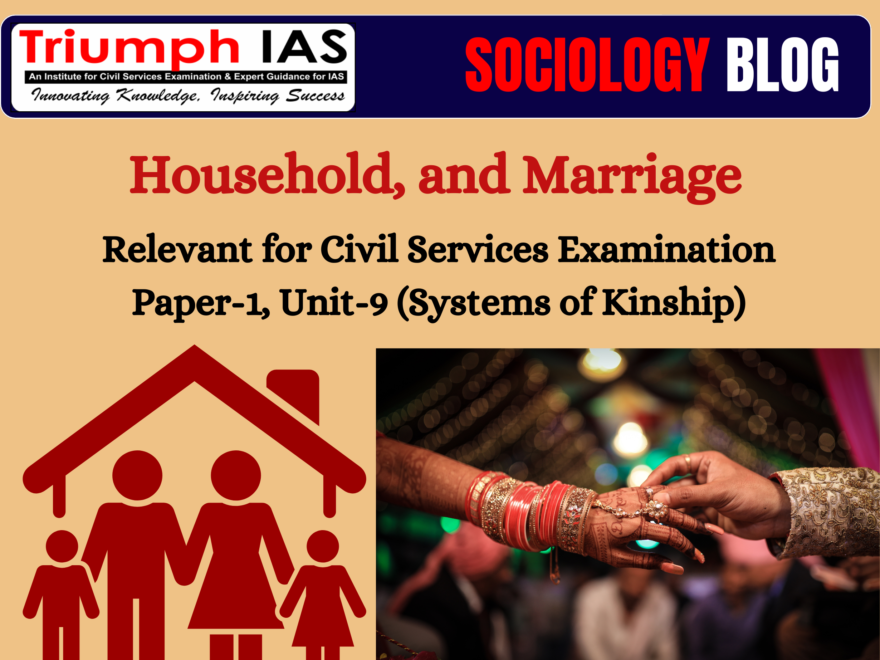Household:
A household includes all the persons who occupy a housing unit. A housing unit is a house, an apartment, a mobile home, a group of rooms, or a single room that is occupied (or if vacant, is intended for occupancy) as separate living quarters. Separate living quarters are those in which the occupants live and eat separately from any other persons in the building and which have direct access from the outside of the building or through a common hall. The occupants may be a single family, one person living alone, two or more families living together, or any other group of related or unrelated persons who share living arrangements.
- The household is a residential grouping defined similarly to the above in which housework is divided and performed by householders. Care may be delivered by one householder to another, depending upon their respective needs, abilities, and perhaps disabilities. Different household compositions may lead to differential life and health expectations and outcomes for household members. Eligibility for certain community services and welfare benefits may depend upon household composition.
- In sociology ‘household work strategy’, a term coined by Ray Pahl, is the division of labour between members of a household, whether implicit or the result of explicit decision–making, with the alternatives weighed up in a simplified type of cost-benefit analysis. It is a plan for the relative deployment of household members’ tied between the three domains of employment:
- In the market economy, including home-based self-employment second jobs, in order to obtain money to buy goods and services in the market;
- Domestic production work, such as cultivating a vegetable patch or raising chickens, purely to supply food to the household; and
- Domestic consumption work to provide goods and services directly within the household, such as cooking meals, child–care, household repairs, or the manufacture of clothes and gifts. Household work strategies may vary over the life-cycle, as household members age, or with the economic environment; they may be imposed by one person or be decided collectively.
Feminism examines the ways that gender roles affect the division of labour within households. Sociologist Arlie Russell Hochschild’s in “The Second Shift and The Time Bind” presents evidence that in two-career couples, men and women, on average, spend about equal amounts of time working, but women still spend more time on housework. Feminist writer Cathy Young responds to Hochschild’s assertions by arguing that in some cases, women may prevent the equal participation of men in housework and parenting.
Marriage
Marriage is the approved social pattern whereby two or more persons establish a family. It involves not only the right to conceive and rear children (who are some-times conceived as an institutionalized preliminary to marriage) but also a host of other obligations and privileges affecting a good many people.
The real meaning of marriage is the acceptance of a new status, with a new set of privileges and obligations, and the recognition of this new status by others. Wedding ceremonies and rituals are merely ways of publicizing and dramatizing this change of status.
In matters of marriage our ethnocentrism is conspicuous. To us it normal that parents should arrange and compel the marriage of two persons who may never even have met. How do they know whether they will love each other? Why are not their wishes consulted? Our reaction illustrates the usual error of ethnocentrism – assuming that people with another culture will not think and feel as we would think and feel if transplanted into their situation.
Type of Marriages:
- Polygyny:It is a form of marriage in which one man marries more than one woman at a given time. It is of two types
- Sororal polygyny: It is a type of marriage in which the wives are invariably the sisters. It is often called sororate.
- Non-sororal polygyny: It is a type of marriage in which the wives are not related as sisters.
- Polyandry:It is the marriage of one woman with more than one man. It is less common than polygyny. It is of two types—–
- Fraternal polyandry: When several brothers share the same wife the practice can be called alelphic or fraternal polyandry. This practice of being mate, actual or potential to one’s husband’s brothers is called levirate. It is prevalent among Todas.
- Non – fraternal polyandry: In this type the husband need not have any close relationship prior to the marriage. The wife goes to spend some time with each husband. So long as a woman lives with one of her husbands; the others have no claim over her.
- Monogamy: It is a form of marriage in which one man marries one woman .It is the most common and acceptable form of marriage.
- Serial monogamy: In many societies individuals are permitted to marry again often on the death of the first spouse or after divorce but they cannot have more than one spouse at one and the same time.
- Straight monogamy: In this remarriage is not allowed.
- Group Marriage: It means the marriage of two or more women with two or more men. Here the husbands are common husbands and wives are common wives. Children are regarded as the children of the entire group as a whole.
Monogamy is a form of marriage in which one woman (at a time) marriage a man and vice versa. There are three theoretical forms of polygamy. One is group marriage, in which several men and several women are all in a marriage relationship with one another. While this is an intriguing theoretical possibility there is no authentic instance of a society in which group marriage has been fully institutionalized, with the possible exception, at one time, of the Marquesans (Murdock). A very rare form is polyandry, where several husbands share a single wife. The Todas of Southern India provides one of our few examples. Here, as in most other cases, polyandry was fraternal, meaning that when a woman married a man, she automatically become wife to all his brother, and they all lived together with little jealousy or discord. Toda polyandry becomes understandable when one learns that they lived in a harsh environment where food was scarce and female infanticide was used to limit population size (Murdock). Only where some situation has created a shortage of women is polyandry likely to be found (Unni). But the scattered handful of societies which practice polyandry serve to show how a practice which seems to us to be contrary to human nature can still be the accepted and preferred pattern for people who are socialized to expect it. The usual form of polygamy is polygyny – a plurality of wives, not usually sisters and generally acquired at different times during one’s life.
In many polygynous societies, the second wife filled the status function of the second Cadillac in our
society. Far from feeling resentful, the first wife often urged her husband to take more wives, over whom she generally reigned as queen bee. Polygyny in operation took many forms in different societies, all of them far removed from the imagination of the normal ethnocentric American. Polygyny is today declining in most of the developing countries but is still common in the more remote tribal areas.
Rules of Marriage: No society gives absolute freedom to its members to select their partners. Endogamy and exogamy are the two main rules that condition marital choice.
- Endogamy: It is a rule of marriage in which the life-partners are to be selected within the group. It is marriage within the group and the group may be caste, class, tribe, race, village, religious group etc.We have caste endogamy, class endogamy, sub caste endogamy, race endogamy and tribal endogamy etc.In caste endogamy marriage has to take place within the caste. Brahmin has to marry a Brahmin. In sub caste endogamy it is limited to the sub caste groups.
- Exogamy: It is a rule of marriage in which an individual has to marry outside his own group. It prohibits marrying within the group. The so-called blood relatives shall neither have marital connections nor sexual contacts among themselves. Forms of exogamy:
- Gotra Exogamy: The Hindu practice of one marrying outside one’s own gotra.
- Pravara Exogamy: Those who belong to the same pravara cannot marry among themselves.
- Village Exogamy: Many Indian tribes like Naga,Garo,Munda etc have the practice of marrying outside their village.
- Pinda Exogamy: Those who belong to the same panda or sapinda( common parentage) cannot marry within themselves.
- Isogamy: It is the marriage between two equals (status)
- Anisogamy: It is an asymmetric marriage alliance between two individuals belonging to different social statuses. It is of two forms – Hypergamy and Hypogamy.
- Hypergamy: It is the marriage of a woman with a man of higher Varna or superior caste or family.
- Hypogamy: It is the marriage of high caste man with a low caste woman.
- Orthogamy: It is the marriage between selected groups.
- Cerogamy: It is two or more men get married to two or more women.
Marital Choice: The process of arranging a marriage shows a fascinating range of possibilities. As shown above, some societies follow a formula whereby the children of certain socially designated Kinsfolk marry each other. The couples can do their own choosing, sometimes with parental guidance or parental veto. The parents can arrange the marriage, with or without considering the couple’s wishes. A wife may be purchases, or perhaps a complicated series of gifts are exchanged between families. Wife capture is not unknown. Each of these patterns is the standard way of arranging marriages in some of the world’s societies. All of them work – within the society in which they exist- and are supported by the surrounding values and practices of the culture. Wife capture worked very well for the Tasmanians, who practiced village exogamy and were not greatly concerned over the differences between one woman and all the others. For our society, it would be less practical. This illustrates the concept of cultural relativism – pattern which works well in one cultural setting might work badly in another.
Changes in Marriage:
Industrialization and urbanization have ushered in changes which have profoundly affected the institution of marriage all over the world. While different societies, and within each society different groups, have responded differentially to industrialization and urbanization, nonetheless certain common trends in the changes affecting marriage are discernible.
- Changes in the Forms of Marriage: Societies with traditions of plural marriages are turning towards monogamy. Due to the general improvement in the status of woman and her gradual emancipation from the clutches of male dominance, even in those societies where polygamy is permissible, incidences of polygamous marriages, and plurality of wives, are on the decrease. In India, the Hindu Marriage Act has banned both polygynous and polyandrous marriages. Even in a Muslim country like Pakistan, legislation was introduced making it necessary for the Kazi to solemnize plural marriages only if the first wife gave her written consent. The trend towards monogamy has also been encouraged by the ideology of romantic and love marriage in which one specific individual is considered to be the ideal partner. However, it would perhaps be wrong to assume that this trend towards monogamy is also towards straight monogamy. While conditions in modern society have made marriage unstable and the marriage bond is revocable, individuals are willing to risk another marriage in order to find happiness. Parents and friends too are sympathetic in this matter. Hence, societies are likely to move towards the condition of serial monogamy, rather than maintain straight monogamy.
- Changes in Mate Selection: In traditional societies like India, where mate selection was entirely a prerogative of parents and elders, a dent has been made. Young men and women are increasingly being given some say in the matter of mate selection. From a position in which they had no say whatsoever concerning whom they were to get married to, a stage has now come in which the concerned individuals are consulted and their consent obtained. In urban middle class families, sons and daughters have even come to enjoy the right to veto marriage proposals initiated by others. In the more advanced and enlightened urban families, parents are now giving opportunities to their children to become acquainted with prospective mates. In India, mate selection through newspaper advertisement has become quite a popular practice among urban middle classes and the latest development is the reported harnessing of the services of computers in bringing potentially compatible mates together.
- Changes in Age of Marriage: In India, where, traditionally, child marriages were prescribed, preferred and encouraged, various efforts were made by social reformers to bring this practice to an end; accordingly, the Child Marriage Restraint Act, popularly known as the Sarda Act, was passed in 1929. However, early marriage continued, in spite of the impact of modern industrialization and urbanization, especially among the rural people. In urban areas, too, there was a strong tendency to get a daughter married off as soon as possible. But with increasing enrolment of girls in schools and colleges and their desire to take up employment, along with the problems of ‘setting down’ in life for the vast majority of boys, the age at marriage is perforce being pushed up. Further, as part of its population policy, the Government has now prescribed the minimum age of marriage as 18 years for girls and 20 years for boys. In urban areas, however, marriages are now generally taking place beyond these prescribed minimum ages.
- Changes in Marriage Rituals and Customs : Contemporary changes in India present us with a paradoxical situation. With greater intrusion of technology and science, it was expected that a secular-scientific outlook would emerge and, consequently, the non-essential rituals and customs would be generally discarded. Religious and social reforms, in all communities have always pleaded for avoiding of wasteful expenditures on meaningless customs and rituals. But observation indicates that, contrary to the expectations of enlightened people, marriages in India are tending to become more traditional insofar as the ritual-custom complex is concerned. Today, there is a revival of many rituals and customs, which, soon after independence, appeared to have become weak. To an extent, this revival is a function of affluence. Many people in society have a lot of money to spend lavishly on weddings, and there is a tendency among the not-so affluent to initiate the affluent.
- Changes in Marriage : Goals and Stability: It was seen earlier that procreation has been the most important function of marriage in traditional societies. In all communities, a large number of children, bestowed higher status upon parents and among Hindus sons were particularly desired. Thus, a large-sized family was one of the cherished goals of marriage, and the blessings showered upon the bridal couple included good wishes for several children. But modern conditions of life have made a large family burdensome; in fact, even those with three or four children are being disfavoured. Several Third World Countries are seized of the problems that exploding populations can cause and are, therefore, committed to encouraging the small family norms. Restriction of family size is the declared official policy of many of these. India, in fact, was the first country to adopt an official family planning programme. In those Asian and African countries where there are democratic governments, through vigorous education efforts, citizens are being made to realize and accept the advantages of limited procreation. China has also adopted a very strict population control programme which involves certain disincentives and punishments for couples that do not restrict procreation. All these efforts are gradually influencing the values of people in India, and other countries. It is being realized that it is better to have about two healthy and well-cared for children than a large number who cannot be adequately fed, clothed or looked after.
As procreation, and along with it parenting role, are tending to become less important, other functions like companionship and emotional support from the spouse and children are becoming the more important goals of marriage. In fact, the younger people today are entering matrimony for happiness and personal fulfillment. The conditions causing marital instability are likely to worsen rather than improve in the future. Our outlook, values and ideals pertaining to marriage are also undergoing change.
What then is the future of marriage? Predictions concerning social life are difficult and risky. But, there appears to be little chance that marriage, as a major event in individual and social life will ever be given up and abandoned. If evidence from western societies is any guide, high rates of divorce will not automatically deter people from getting married. Notwithstanding marital instability, the individual’s quest for finding happiness in marriage will continue.
The End of the Blog : Household, and Marriage

|





















